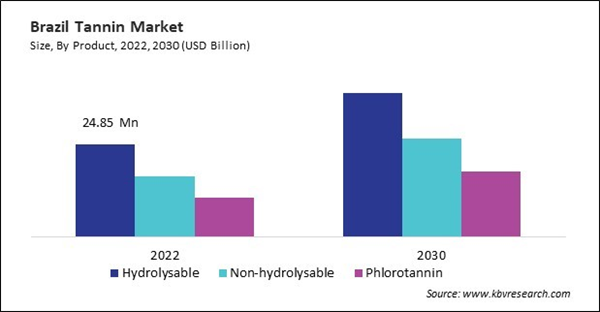The Latin America, Middle East and Africa Tannin Market would witness market growth of 7.2% CAGR during the forecast period (2023-2030). In the year 2026, the LAMEA market's volume is expected to surge to 272.82 Hundred Tonnes, showcasing a growth of 7.0% (2023-2030).
Non-hydrolysable tannins, also known as condensed tannins or proanthocyanidins, are characterized by their polymerized structure derived from flavan-3-ol units, such as catechin and epicatechin. These are found in various plant sources, including tree barks, fruits, seeds, and leaves, with notable examples being grape seeds, tea leaves, and pine bark. Therefore, the Brazil Market consumed 18.56 hundred tonnes of Non-hydrolysable tannins in 2022.
The Brazil market dominated the LAMEA Tannin Market by Country in 2022 and would continue to be a dominant market till 2030; thereby, achieving a market value of $82.8 Million by 2030. The Argentina market is showcasing a CAGR of 7.7% during (2023 - 2030). Additionally, The Chile market would register a CAGR of 8.7% during (2023 - 2030).
Companies are exploring new applications and delivery systems for these, expanding their use beyond traditional industries and unlocking new opportunities in pharmaceuticals, personal care, and environmental remediation. In addition, consumers are increasingly seeking transparency and traceability in their products, including information about ingredients, sourcing practices, and production methods.
Companies in the market are responding to this trend by implementing transparent supply chains, sustainable sourcing practices, and certifications that validate the authenticity and quality of their products. Companies must adhere to regulatory guidelines governing the use of these in food, beverages, pharmaceuticals, cosmetics, and other products, ensuring safety, efficacy, and compliance with labelling requirements.
The growing pharmaceutical industry in Saudi Arabia could also impact their supply chain dynamics. With increased demand, there might be a need for more efficient sourcing and production methods to meet the requirements of pharmaceutical manufacturers. According to the International Trade Administration (ITA), Saudi Arabia accounts for nearly 60 percent of the pharmaceutical products purchased by the Gulf Cooperation Council (GCC). In conclusion, the expansion of the pharmaceutical industry and the growing food and beverage industry in the region is propelling the market’s growth.
Based on Source, the market is segmented into Plants, and Brown Algae. Based on Product, the market is segmented into Hydrolysable, Non-hydrolysable, and Phlorotannin. Based on Application, the market is segmented into Leather Tanning, Wood Adhesives, Wine Production, Anti-corrosive Primers, and Others. Based on countries, the market is segmented into Brazil, Argentina, Chile, Egypt, South Africa, Nigeria, and Rest of LAMEA.
Non-hydrolysable tannins, also known as condensed tannins or proanthocyanidins, are characterized by their polymerized structure derived from flavan-3-ol units, such as catechin and epicatechin. These are found in various plant sources, including tree barks, fruits, seeds, and leaves, with notable examples being grape seeds, tea leaves, and pine bark. Therefore, the Brazil Market consumed 18.56 hundred tonnes of Non-hydrolysable tannins in 2022.
The Brazil market dominated the LAMEA Tannin Market by Country in 2022 and would continue to be a dominant market till 2030; thereby, achieving a market value of $82.8 Million by 2030. The Argentina market is showcasing a CAGR of 7.7% during (2023 - 2030). Additionally, The Chile market would register a CAGR of 8.7% during (2023 - 2030).
Companies are exploring new applications and delivery systems for these, expanding their use beyond traditional industries and unlocking new opportunities in pharmaceuticals, personal care, and environmental remediation. In addition, consumers are increasingly seeking transparency and traceability in their products, including information about ingredients, sourcing practices, and production methods.
Companies in the market are responding to this trend by implementing transparent supply chains, sustainable sourcing practices, and certifications that validate the authenticity and quality of their products. Companies must adhere to regulatory guidelines governing the use of these in food, beverages, pharmaceuticals, cosmetics, and other products, ensuring safety, efficacy, and compliance with labelling requirements.
The growing pharmaceutical industry in Saudi Arabia could also impact their supply chain dynamics. With increased demand, there might be a need for more efficient sourcing and production methods to meet the requirements of pharmaceutical manufacturers. According to the International Trade Administration (ITA), Saudi Arabia accounts for nearly 60 percent of the pharmaceutical products purchased by the Gulf Cooperation Council (GCC). In conclusion, the expansion of the pharmaceutical industry and the growing food and beverage industry in the region is propelling the market’s growth.
Based on Source, the market is segmented into Plants, and Brown Algae. Based on Product, the market is segmented into Hydrolysable, Non-hydrolysable, and Phlorotannin. Based on Application, the market is segmented into Leather Tanning, Wood Adhesives, Wine Production, Anti-corrosive Primers, and Others. Based on countries, the market is segmented into Brazil, Argentina, Chile, Egypt, South Africa, Nigeria, and Rest of LAMEA.
List of Key Companies Profiled
- Tannin Corporation
- Ajinomoto Co., Inc.
- Esseco S.r.l
- UCL Company (Pty) Ltd
- LAFFORT
- W.Ulrich GmbH
- TANIN d.d. Sevnica.
- Silvateam S.p.a.
- Indena S.p.A.
- Sisco Research Laboratories Pvt. Ltd.
Market Report Segmentation
By Source (Volume, Hundred Tonnes, USD Billion, 2019-2030)- Plants
- Brown Algae
- Hydrolysable
- Non-hydrolysable
- Phlorotannin
- Leather Tanning
- Wood Adhesives
- Wine Production
- Anti-corrosive Primers
- Others
- Brazil
- Argentina
- UAE
- Saudi Arabia
- South Africa
- Nigeria
- Rest of LAMEA
Table of Contents
Chapter 1. Market Scope & Methodology
Chapter 2. Market at a Glance
Chapter 3. Market Overview
Chapter 4. LAMEA Tannin Market by Source
Chapter 5. LAMEA Tannin Market by Product
Chapter 6. LAMEA Tannin Market by Application
Chapter 7. LAMEA Tannin Market by Country
Chapter 8. Company Profiles
Companies Mentioned
- Tannin Corporation
- Ajinomoto Co., Inc.
- Esseco S.r.l
- UCL Company (Pty) Ltd
- LAFFORT
- W. Ulrich GmbH
- TANIN d.d. Sevnica.
- Silvateam S.p.a.
- Indena S.p.A.
- Sisco Research Laboratories Pvt. Ltd.
Methodology

LOADING...









